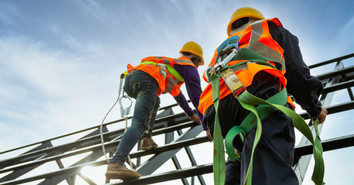Working at height is an essential aspect of many industries, from construction and maintenance to telecommunications and forestry. While these tasks are vital, they come with inherent risks that you must carefully manage to ensure each worker’s safety. Falls from heights remain one of the leading causes of workplace injuries and fatalities, making proper safety protocols an absolute necessity. You can prevent many of these accidents by adhering to comprehensive safety measures and fostering a culture of vigilance. Protect yourself with these ten critical safety tips that every professional and employer must follow when working at height.

Assessing Risks Before Starting Work
The first and most important step when undertaking any task at height is to conduct a thorough risk assessment. The assessment should involve identifying potential dangers, evaluating the likelihood of accidents, and developing strategies to minimize risks. Important considerations include weather conditions, surface stability, equipment suitability, and the physical health of the workers involved.
Risk assessments should also consider the potential for falling objects and emergency evacuation procedures. By addressing these risks in advance, employers and workers can lay the groundwork for a safer working environment.
Proper Use of Safety Equipment
Using the correct safety equipment is non-negotiable when working at height. Employers and employees should carefully select key equipment, such as harnesses, lifelines, and helmets, based on the specific task at hand. Ensure you regularly inspect and maintain every piece of equipment for its reliability.
You must also set up appropriate scaffolding, ladders, and guardrails according to current industry safety standards. Train workers to use equipment correctly, ensuring optimal protection. Neglecting safety gear or using damaged equipment can dramatically increase the likelihood of accidents. Climbing rigging equipment and other critical pieces of gear can also ensure you and your employees remain safe while at height.
Comprehensive Training for Workers
Well-trained employees are significantly less likely to experience incidents while working at height. All workers should undergo thorough training to understand the risks associated with height-related tasks and the best practices for staying safe.
Training sessions should include theoretical knowledge and practical demonstrations, and cover topics such as fall prevention, equipment handling, and rescue techniques. Regular refresher courses can reinforce this knowledge and equip workers to respond effectively to new challenges or tools introduced in the industry.
Maintaining Site Organization
A cluttered or disorganized site presents hazards that can amplify risks, particularly when working at height. Tools, materials, and debris left in inappropriate areas may cause slipping or tripping, endangering workers on the same level as well as those below.
Employers should implement strict housekeeping guidelines to keep workspaces clean and organized. Store all equipment and materials securely, and ensure access routes to ladders or platforms remain unobstructed. A well-organized site promotes efficiency while significantly reducing the chance of accidents.
Monitoring Weather Conditions
Weather plays an enormous role in the safety of working at height. High winds, rain, or icy surfaces can make tasks incredibly dangerous, heightening the risk of slips, falls, or equipment failures. Carefully monitor the job site’s conditions to ensure they are suitable for the planned activities before beginning work.
Also, train workers to recognize when weather changes pose a threat and when to halt operations. Scheduling tasks for appropriate times and having contingency plans in place can make all the difference in maintaining workplace safety.
Establishing Emergency Procedures
Even with the best precautions, accidents can still occur, which is why emergency preparedness is vital. Employers should develop clear, well-documented rescue and emergency procedures tailored to the specifics of their worksites. Having functional communication systems, first-aid kits, and an emergency response team on standby is necessary to handle crises efficiently.
Workers must know how to promptly respond during emergencies, whether it involves aiding a fellow worker or evacuating the site safely. Preparation in this regard minimizes harm and can save lives.
Encouraging Communication and Teamwork
Effective communication among workers is crucial when performing height-related tasks. Workers should maintain constant awareness of their surroundings and communicate regularly about potential hazards or shifts in working conditions.
Team coordination is particularly important when handling large or unwieldy objects at a height, as it reduces the potential for accidents or strain injuries. Encouraging workers to speak up about safety concerns fosters a proactive approach to risk management and creates a more supportive working environment.
Regular Inspections
Routine inspections of the equipment and worksite are essential to address any developing safety issues before they become severe. Routinely check all tools and machinery for defects, inspect scaffolding and ladders for stability, and test safety harnesses to ensure proper function.
Inspections should also include evaluations of the surroundings, such as assessing the structural integrity of platforms and ensuring pathways remain clear. Employers can promptly rectify problems and maintain safer working conditions for everyone involved by adhering to consistent inspection schedules.
Limiting Fatigue and Overexertion
Working at height requires sustained focus, physical strength, and mental alertness. Fatigue or overexertion can impair judgment and increase the likelihood of mistakes, making it a substantial risk factor.
Employers should monitor workload distribution, ensure workers have adequate breaks, and encourage hydration and healthy eating habits. Workers should also speak up if they feel unfit to perform a task due to exhaustion. Taking steps to address these issues can lead to better overall outcomes and prevent accidents stemming from human error.
Promoting a Safety-First Culture
Ultimately, the most effective way to ensure safety when working at height is to cultivate a robust safety culture within the workplace. Every employee, from management to site workers, must prioritize safety above all else.
Promoting a safety-first culture involves reinforcing the importance of following protocols through ongoing education, open communication, and rewarding safe behavior. A safety-first culture reduces complacency and encourages everyone to take ownership of workplace safety, fostering an environment where everyone actively manages risks and minimizes accidents.

Protect Yourself at All Times
Working at height comes with inherent challenges that demand careful planning, the right equipment, and a commitment to safety. Employers and workers alike can significantly reduce the risks by adopting these essential safety tips to follow while working at height, ensuring they complete tasks effectively and without incident. A proactive approach and continuous focus on safety will protect lives and contribute to a more productive and positive working environment.

